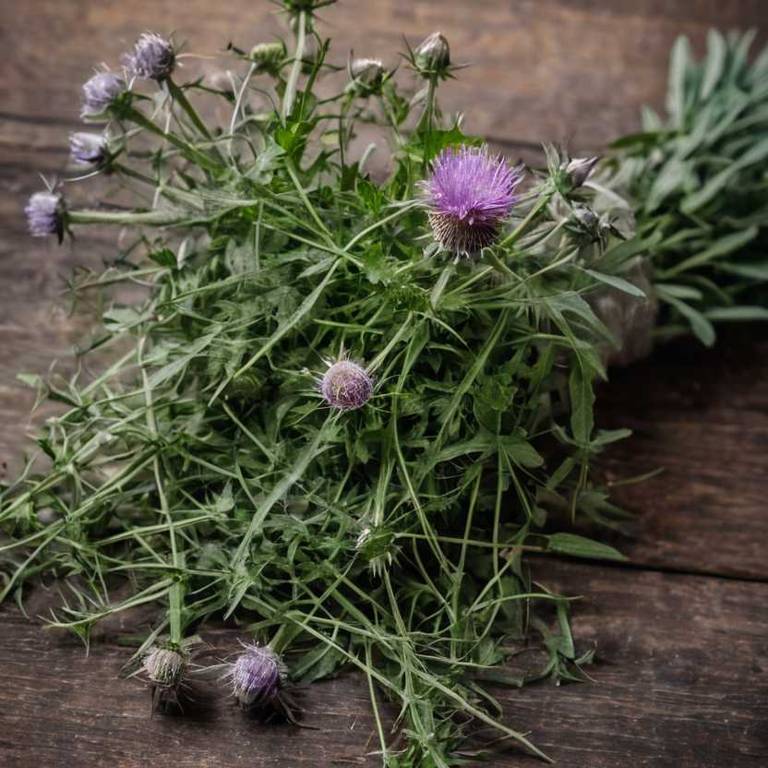By Leen Randell
Updated: Jul 07, 2024
What to know about Cirsium lanceolatum (thorny burdock) before using it medicinally

Cirsium lanceolatum, commonly known as thorny burdock, is a medicinal herb that has been prized for its health benefits, including its ability to reduce inflammation, improve digestion, and support immune function.
As a horticultural crop, it is valued for its robust and adaptable nature, making it a popular choice for gardens and landscapes in temperate regions. Botanically, Cirsium lanceolatum is classified as a member of the Asteraceae family, with a distinctive thistle-like appearance characterized by spiky flowers and jagged leaves.
Historically, the herb has been documented in various traditional medicinal systems, including traditional Chinese medicine and folk medicine in Europe, where it was often used to treat a range of ailments.
This article explains the medicinal, horticultural, botanical, and historical aspects of Cirsium lanceolatum.
What are the medicinal properties of Cirsium lanceolatum?
Cirsium lanceolatum helps with digestion, skin issues, and inflammation. Its roots and leaves are used to treat gastrointestinal disorders, wounds, and eczema. Traditional medicine has employed its extracts for various ailments.
The plant's active constituents include flavonoids, phenolic acids, and terpenoids, which contribute to its medicinal properties. These compounds exhibit antioxidant, anti-inflammatory, and antimicrobial activities, providing relief from various health conditions.
The plant's roots and leaves are the primary parts used for medicinal purposes. The roots are rich in mucilages, which soothe digestive issues and skin irritations, while the leaves contain sesquiterpenes that exhibit anti-inflammatory and antimicrobial properties.
Improper use of Cirsium lanceolatum can lead to allergic reactions, skin irritation, and gastrointestinal upset. Ingestion of large quantities may cause liver and kidney damage, highlighting the need for cautious handling and dosing.
Precautions when using Cirsium lanceolatum medicinally include identifying the correct species, avoiding excessive dosing, and consulting a healthcare professional, especially for pregnant or breastfeeding women and individuals with pre-existing medical conditions.
What are the horticulural aspects of Cirsium lanceolatum?
Cirsium lanceolatum grow in well-drained soil, tolerating full sun to partial shade. It thrives in zones 3-8, preferring a pH range of 6.0-8.0. The plant grows up to 5 feet tall and 2 feet wide.
Thorny burdock requires a large planting area due to its extensive root system. Plant seeds 1/8 inch deep and 12-18 inches apart in late spring to early summer. Water regularly, but avoid overwatering, which can lead to root rot.
Harvest thorny burdock roots in the fall, after the first frost. Dig carefully to avoid damaging the roots. Cut the stalks to the ground, and let the plant regrow. Harvest the leaves and flowers as needed, but avoid over-harvesting, which can weaken the plant.
Thorny burdock is susceptible to several pests, including aphids, whiteflies, and spider mites. Fungal diseases such as powdery mildew and downy mildew can also affect the plant. Regularly inspect the plant for signs of infestation or disease, and take action promptly if necessary.
What are the botanical aspects of Cirsium lanceolatum?
Cirsium lanceolatum is a perennial plant characterized by its spiny stems, lanceolate leaves, and globular flower heads. Stems are 30-100 cm tall, with a wings-like phyllode that clasps the stem. Leaves are 5-15 cm long and 2-7 cm wide, with a crenate margin. Flowers are 5-12 mm long and 3-5 mm wide.
Cirsium lanceolatum belongs to the family Asteraceae, tribe Cardueae. Its taxonomic classification is as follows: Kingdom: Plantae, Clade: Angiosperms, Clade: Eudicots, Clade: Asterids, Order: Asterales, Family: Asteraceae, Genus: Cirsium, Species: C. lanceolatum. It is a member of the thistle group.
The plant has several variants, including Cirsium lanceolatum var. lanceolatum and Cirsium lanceolatum var. leptophyllum. These variants differ in their leaf shape and flower size. The var. leptophyllum has narrower leaves and smaller flowers.
Cirsium lanceolatum is native to North America, where it can be found from Canada to Mexico. It grows in dry to moist soils in open fields, roadsides, and waste areas.
The life cycle of Cirsium lanceolatum is as follows: seed germination occurs in spring, seedlings emerge, and plants grow to maturity in summer. Flowers form in late summer, and seeds mature in fall. Plants die back in winter, but new seedlings emerge in spring.
What are the historical aspects of Cirsium lanceolatum?
Cirsium lanceolatum is a plant with a long history of medicinal and culinary uses. Its roots, leaves, and seeds have been used to treat a range of ailments, from skin conditions to digestive issues. It has been a staple in traditional medicine for centuries.
In ancient mythology, Cirsium lanceolatum was associated with the god Dionysus, who was said to have used the plant's sap to purify water. The plant was also mentioned in Homer's Odyssey as a remedy for various afflictions. Its mythological connections reflect its perceived healing properties.
The plant has been imbued with symbolic meanings across cultures. In ancient Greece, it represented purification and healing, while in some African cultures, it symbolizes protection and good fortune. Its versatility has led to diverse interpretations of its significance.
Historical texts describe the plant's properties and uses. The Greek physician Hippocrates (460-370 BCE) mentioned its medicinal applications, while the Roman naturalist Pliny the Elder (23-79 CE) noted its use as a purgative. The plant's versatility has been documented by various herbalists and medical practitioners.
Archaeological evidence reveals the plant's presence in ancient artifacts. Fossilized seeds and roots have been found in ancient settlements, while artifacts from ancient civilizations feature depictions of the plant. These discoveries demonstrate the plant's significance in the past, from medicine to mythology.